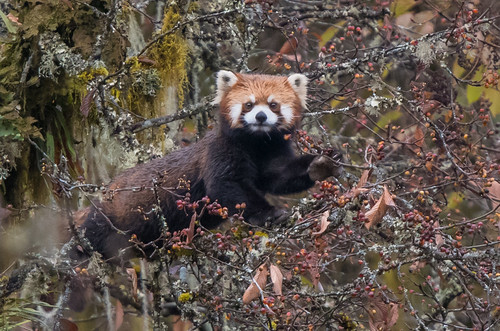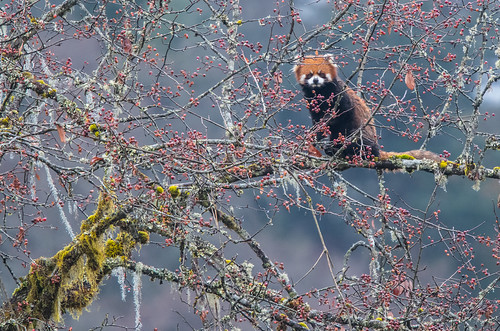Would we see them in the two days we had at the site where they are known to be plentiful. We were above 2,500 metres (8,000 ft) and the first morning at dawn was cold, dank and misty with low cloud cover. Lots of berries. No pandas. We scanned trees near and far. Late in the day, one was spotted in a distant tree by our guide, the estimable Sid Francis, and some of our party keeping up with the advanced guard saw it through the telescope before it descended into the bamboo. Then one member walking down the road wondered what two local tourists were looking at. A panda had wandered across the road in front of them, climbed into a tree for a few minutes and then disappeared into the bamboo. They but not us were utterly delighted. Would we do better the next day?
The morning was brighter and doing exactly the same thing along the same route, a panda was spotted in a tree. The view was distant but all its markings could be seen as it moved around eating the red berries. Then, in a much closer tree, a panda appeared, and then another, and another. In 90 minutes we saw seven different pandas, with a final one being spotted a while later.
Here is the video I took which shows several different individuals:
Over the decades, the classification of the Red or Lesser Panda (Ailurus fulgens) has been the subject of much research and debate, as indeed has that of the Giant Panda (Ailuropoda melanoleuca). While the latter was established as a bear, for many years, the Red Panda was included with the raccoons and their ilk in the family Procyonidae. It is shown as such in my copy of the 4th edition of Walker’s Mammals of the World, published in 1983. However, evidence from molecular genetics since 2000 clearly indicates that it is a musteloid, requiring a family of its own (Ailuridae) within the superfamily Musteloidea that includes stoats, weasels, badgers, otters, raccoons and skunks.
The Red Panda has been classified as 'Endangered' by IUCN since 2015, up from 'Vulnerable' in 2008. I am not convinced that the present classification is warranted by the evidence cited though, especially as the Giant Panda has been moved in the opposite direction. 'Crying wolf' by relying on the precautionary principle is a distinct possibility with such a relatively large population. What is clear is that active measures to protect habitats and to clamp down on hunting are necessary.
The Red Pandas of China have thicker, darker fur than those from the northern Indian subcontinent and it is inevitable that the splitters have labelled them as sub-species and the phylogenetic species concept devotees as two species. But I am not going to be led into that discussion here. We were in Sichuan to see real Red Pandas in their natural habitat.
Tim Melling (Flickr site here) was taking still photographs of the pandas at the same time I was shooting video. Here are two of his superb pictures:

*Naturetrek tour Wild China: Sichuan's Birds and Mammals

No comments:
Post a Comment